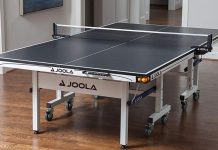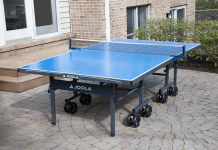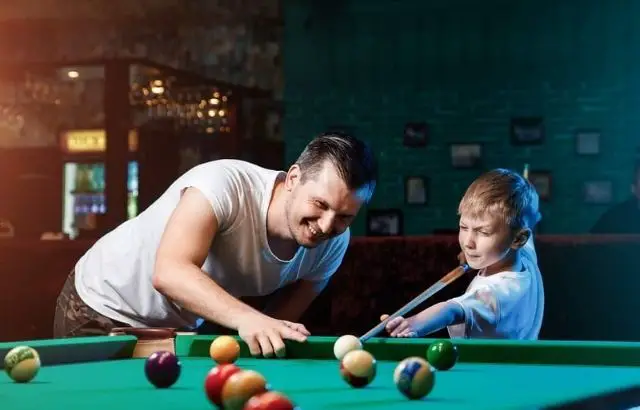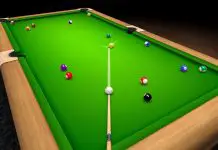It’s more fun to grip the pool cue, aim it, and try to run your target ball inside the pocket. If you ignore the fundamentals of proper grip, attitude, and alignment, you may not have much success in sinking your target ball. In this guide, I will teach you how to hold a pool stick.
It would help if you started with the basics.
And one of the most important basic pool skills is learning the right way to hold a cue stick. Properly holding the rod will increase your accuracy, control, and strength.
In this article, we will review three elements of how to hold a pool stick:
- Where to hold pool cue (hand position)
- How to hold a pool cue
- How to shape your bridge
Each section will start with the basic rule and then further clarification.
Master these basic techniques, and you will become an excellent pool player. It’s easy. Let’s get started.
Table of Contents
Where to Hold the Pool Cue
Rule: Your forearm should be vertical to your pool rod when hitting the cue ball.
The first step in understanding the correct way to hold your pool rod is to find out where to place it. This comes down to the position of the hand. New players usually hold the stick too far forward or too far towards the cue ends.
Finding the sweet spot where to put your hand seems like a mystery. But it’s easy.
You need to know that you should place the other hand about 6 to 8 inches straight behind the aiming Q ball according to the standard rule.
When trying to figure out how to hold a stick, remember this basic principle: your pool should be perpendicular to your pool stick when you approach the cue ball.
Follow your planned shot many times, hit the cube hit only when you are 100% sure your body is firm, your pull is right, and the shot you will make is correct as you want.
So, to check your hand’s placement, line up your cue so that the help cue is right in front of the ball.
Get tip as close as possible without hitting the cue ball. Having the best pool cue is also important.
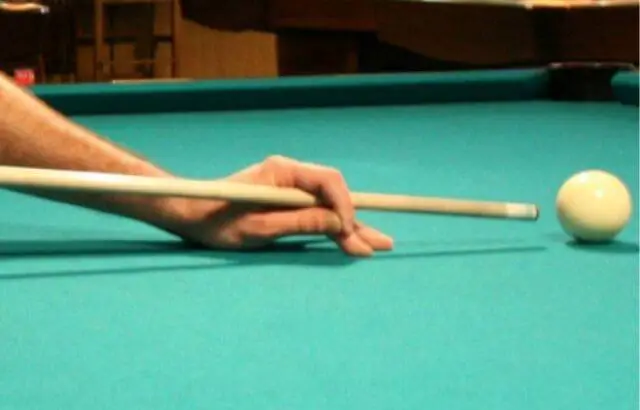
Is your Rod Perpendicular at this Stage?
- If not, move your hand accordingly.
- In a comfortable position, let your wrists hang straight below your waist.
- This will keep your cue nice and low, which will help with your overall alignment and shot accuracy.
- If your hand is slightly forward when hitting the cue ball, that’s fine.
- Your hand should not be at an angle to the back when you approach the cue ball.
How to Hold a Pool Cue
Rule:
- Keep your grip natural, light, and light.
- Now that you know where to put the stick, it’s time to work on your grip.
- Don’t grip your pool cue too firmly.
- One of the most common mistakes beginner pool players make is holding their pool rods too tightly. And a tight grip is usually a way to try to hit a ball with force.
- Many early pool players want to hit the ball with force.
- Yes, trying to pocket the target ball with power is very attractive.
- Of course, there is nothing wrong with adding a little strength with a specific shot. But that doesn’t mean you need to grab a pool stick with a whitetail.
- And this also happens with experienced players.
- When you’re trying to make a hard shot, it’s natural to get tense.
- You wrap your palm around the cue and grip, thinking this will help give you more control and accuracy.
- But whether you’re playing soft shots with precision or trying to hit hard breaks, this is the perfect way to hold a pool stick.
- If you hold the cue with a full tight grip, the pool stick will come up and down during your swing.
- And if you try to push it lower and parallel by holding it tightly, you will use more muscles in your arms and shoulders.
- This means you will lose control of the pendulum swing, which depends on the original and rear motion along with your elbows and front.
Always keep your grip natural, light, and relaxed.
- If you hold your pool stick too tightly, changing the light and relaxed grip will make a difference to the world.
- But there’s a bit of a discussion about how to lose your grip should be. Some players shoot with a very loose grip, mostly using fingers.
- Others prefer to rest a little on the palm to increase control. His hand seems to be wrapped around the stick.
- Either way, world champion 8-ball player Gareth Potts suggests:
- A good way to find this natural balance of comfort and control is to place a pool stick on the table. Now choose it with as little effort as possible. Now, this is how you should hold the stick!
- If it’s too simple, some specific pointers should help.
- First, place the cue in the fleshy part of your hand between your thumb and forefinger. Now calmly wrap your thumb and initial three fingers about the stick. If it is more comfortable, your pinky finger may remain loose.

The palm of your hand should be barely touched the cue.
- With this light grip, your control will come from your index and middle fingers. The cue should be placed on the fingers with your grip.
- Some players recommend freeing your middle, ring, and pink fingers during a backstroke.
- However, expert billiards instructor Barry Stark puts it. It is not necessary to free the fingers. Instead, the fingers should only be inverted and rotated during your swing.
- Releasing your fingers allows your wrists to remain stable during your stroke. This simplifies straight and level swings.
Bridge
Rule:
- Use a static open bridge by stretching your bridge arm over the table and making a ‘V’ between your thumb and forefinger.
- Currently, that you’re familiar with how to hold a pool stick with an accepted and relaxed grip, it’s time to work on your bridge. This bridge deserves its post. Sure, it usually takes a while to complete this aspect of your game.
- The most important part of the instruction regarding your bridge should be that it is relevant. Thus, it is something that needs to be practiced with repetition. When you find the right bridge for your game, you should stick with it. There are two basic bridge types for most shots: ‘open bridge’ or ‘closed bridge.’
- The closed bridge is typically best for higher players who shoot hard shots with plenty of spins with action.
- If the 8 is in an obscure position and is not likely to clear, move it or the bouncing ball and wait until you have a shot.
- If you are a new player, it is better to work on an open bridge.
- To use the open bridge, first, place your hand on the table. Now hold your hand and raise your knuckles sensibly.
- This is your base for an open bridge. It should be firm and stable. And you can add stability by spreading your fingers.
Now;
- Also, you can raise or lower the bridge as needed by pulling or pushing your fingers inwards.
- Now press your thumb to make a “V” in front of the top of your index finger.
- Your gesture will rest on the base of this “V” made by your thumb and forefinger.
- Whether you use a deep or shallow “V” is usually a matter of personal choice.
- But the contact area between your index finger and thumb should be large enough to make the cue firm and comfortable. You can then use the fleshy parts of your fingers to guide your shots.
- The stick should be a smooth and straight glide.
- With a firm and stable base, this way you create a comfortable and consistent bridge for most of your shots.
Learn, practice, and improve
There you have it. The three basic elements of how to keep a pool stick, if used, will dramatically improve your billiards game.
How to Hold a Pool Stick: FAQs
How can you put Q tips on a pool stick?
- Eliminate the previous pool cue tip.
- Clear the pool c ferrule.
- Organize the pool cue tip.
- Put the pool cue tip on the ferrule.
- Cut the ferrule cue tip and sand.
- Shape the pool cue tip.
Why do people put chalk on pool sticks?
Chalk prevents waste from sliding the ball prematurely, spoiling the shot (called ‘miscue’). Over time, the help of the pool stick is worn and becomes easier to use. Chalk provides the friction needed to make a shot.
How do you teach a child to hold a pool stick?
Teach them first how to hold the back of the cue while using your hand to bridge. Second, pull them up, and you stroke the cue. It is surprising to repeat this a few times. That’s exactly if they want to rest between the index finger and the thumb or between the index and middle finger.
Conclusion
Mastery of how to hold a pool stick is one of the fundamentals that pool players must go down to improve.
Holding the pool stick properly can be broken into two main parts (bridge and grip), but there is more to it.
Practice the fundamentals of pull, grip, and stroke. It will take time to learn it properly, but you will get there. It can take players hours, days, weeks, or even months to take down once you take it off. It will significantly improve your shot-making ability and overall game.

Mark is a Bloomberg BusinessWeek-based digital entrepreneur, blogger, and table tennis enthusiast. He is a former professional table tennis player with the career-best USATT ranking of 2689. He is also an ITTF Level 3 certified coach and conducts weekend coaching programs in and around the New York area. Mark is also a pool player by passion. He was first introduced to the game of pool at a very early age by his granddad. He had a natural knack for the game and quickly learned the ropes, and by the time he was 15, he was already participating in local leagues. He aims to make it into the APA league someday! Mark started his own blog by starting Indoor Games Zone, where he loves to share his years of experience with the audience. He covers ping pong, pool, air hockey, shuffleboard, and foosball.
- Ping pong
- Pool
- Air Hockey
- Shuffleboard
- Foosball

![Stiga XTR Pro Review | 1,559+ Global Ratings (In-Depth Guide) [year] Stiga XTR Pro Review](https://indoorgameszone.com/wp-content/uploads/2021/08/Stiga-XTR-Pro-Review-218x150.jpg)

